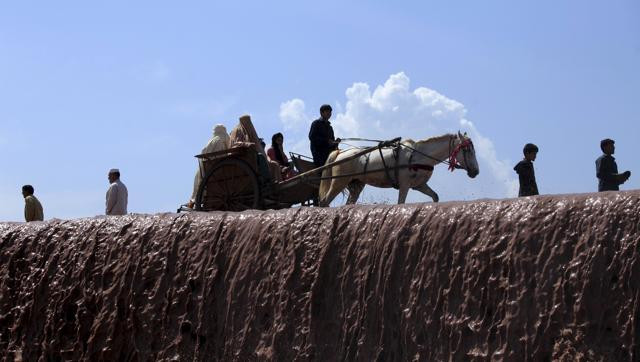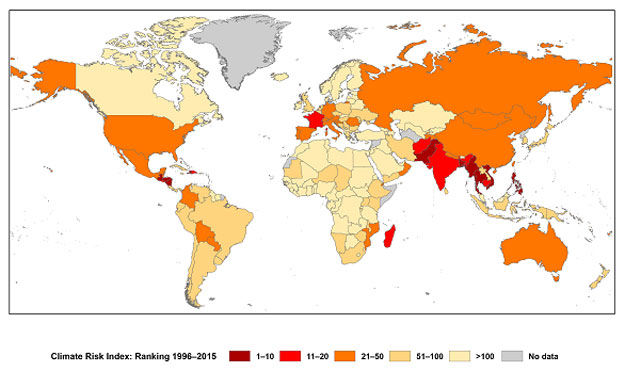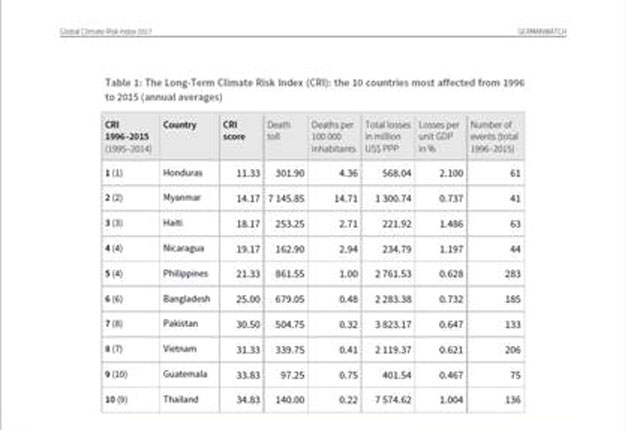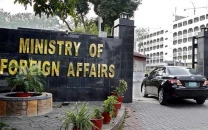Has Pakistan really 'improved' when it comes to tackling climate change?
In the Long-Term Climate Risk Index from 1996 to 2015 Pakistan ranked seventh after facing 133 extreme weather events

PHOTO: Reuters
 Pakistan highlighted on the map in dark red in the latest index.
Pakistan highlighted on the map in dark red in the latest index.In the Long-Term Climate Risk Index (CRI) from 1996 to 2015 (annual averages), Pakistan ranked seventh, losing US$3.823 billion and 0.647 per cent of the GDP and facing 133 extreme weather events in this time period, compared to last year’s Long-Term Climate Risk Index (1995-2014) where Pakistan ranked eighth. According to David Eckstein, Policy Advisor for Climate Finance and Investments at Germanwatch and one of the authors of the report, “As can be seen in our Climate Risk Index this year, Pakistan continues to be most affected by extreme weather events. Last year, Pakistan was especially affected by a severe heat wave in June 2015 that killed more than 1,600 people. Only two other countries suffered more casualties from climatic events in 2015. Furthermore, when looking at the 20-year period from 1996-2015, Pakistan also ranks amongst the 10 countries most affected over these two decades, mostly due to continuous impacts from disastrous floods.”
K-P forests lose 74% density, claim officials
When asked whether the Ministry of Climate Change (MoCC) can take credit for reducing Pakistan’s vulnerability to climate change Dr Qamar-uz-Zaman Chaudhry, lead author of Pakistan's National Climate Change Policy and former DG at Pakistan Meteorological Department said, “The MoCC can take credit for many climate change related actions taken in the country, but not for the country's vulnerability reduction in Global Climate Risk Index 2017. This is because of generally drier conditions prevailing in the country, and secondly because there is not much improvement from the previous ranking.”
According to CEO of South Punjab Forest Company and a senior forester Tahir Rasheed, “Although the report does not include Pakistan in the list of 10 most vulnerable countries in the short-term index, the long-term climate risk index (1996-2015) cautions that climate change will be a hard reality in the long run.” He further adds, “Pakistan’s policymakers and civil society need to make concentrated efforts to handle the impacts of extreme weather events.
As we are aware the agriculture, forestry and land-use sectors account for almost a quarter of global greenhouse gas emissions, world leaders gathered in Morocco (COP22) should also recognise the importance of forests in addressing the climate vulnerabilities of developing countries like Pakistan. Initiatives such as the Billion Tree Tsunami Afforestation Project, Prime Minister’s Green Pakistan Initiative and the South Punjab Forest Company will directly and indirectly contribute to improving Pakistan’s long-term climate vulnerability ratings.”
 Pakistan ranked seventh in long-term climate vulnerability index.
Pakistan ranked seventh in long-term climate vulnerability index.Dr Pervaiz Amir, Director at Pakistan Water Partnership also commented on Pakistan’s vulnerability in the Global Climate Risk Index 2017. “Pakistan has consistently been ranked among top 10 countries most vulnerable to climate change. Pakistan’s vulnerability after the 2010 floods ranked very high. Last year, we had the most devastating heat wave that led to over 2,000 fatalities despite reports of 1,200 only,” he says. “On population basis alone, Pakistan would be amongst top three countries vulnerable to climate change,” he adds.
Regarding the efforts of the MoCC for climate adaptation and mitigation, Dr Amir says, “The ministry is serious about adaptation but lacks the resources. A good start would be national and provincial adaptation centres which would be different from the National Disaster Management Authority. These adaptation centres would deal with all key aspects of adaptation. Making Pakistan greener and water secure are top priorities for adaptation in Pakistan. Even the Lahore High Court is moving on seeing fast track action on climate change. The current drought in Pakistan may be a wakeup call, so is the ever increasing impact of smog.”
CO2 emissions level off, still too high to save climate: report
It is important to note that the majority of countries in the short- and long-term index are developing countries in the 'low' or 'lower-middle' income category. These countries have low emissions but are most affected from the impacts of climate change. Germanwatch has once again warned Pakistan to boost adaptation efforts and to take concrete measures to deal with the impacts of extreme weather events. It will be criminal negligence on our part, if we failed again to protect our people from the disastrous impacts of climate change and later beat our chests complaining about low emissions and high vulnerability.
You can read the full report here: http://germanwatch.org/de/download/16411.pdf
Syed Muhammad Abubakar is an international award-winning environmental writer with an interest in climate change, deforestation, food security and sustainable development. He tweets @SyedMAbubakar



















COMMENTS
Comments are moderated and generally will be posted if they are on-topic and not abusive.
For more information, please see our Comments FAQ